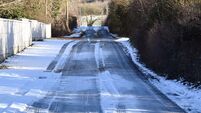Weave a spindle into your autumn planting
But don’t worry if you were intending to get a few in but never got around to it. Our climate is getting milder and you should be all right up until Christmas at least.
The thinking behind planting trees, particularly deciduous trees, in late autumn or early winter is to allow several months for the rain to wash soil around the roots and expel any air pockets left in the planting hole before the tree starts to grow in the spring. Soil temperatures are also a bit higher than in January and February — it’s not good to plant in frozen ground.
If you’re wondering what kind of tree to plant, particularly in a smallish garden, I’d like to put in a word for spindle.
Spindle is a native species and that makes it better for wildlife.
Nurseries and garden centres sometimes sell it under its botanical name of euonymus and, if attracting wildlife is important to you, try and make sure you are getting the Irish native species because there are some exotic ones and some cultivated varieties.
Its one disadvantage is that its berries and foliage are mildly poisonous to humans and animals. It’s not a good species to plant where sheep are likely to browse. But the berries are not poisonous to birds and provide a very important source of winter food for them.
Classifying it as a native species is undoubtedly correct but is also a bit of an assumption, because no traces of it have been found in the prehistoric pollen record. The reason for this is that almost all our pollen samples come from peat bogs where the soil is very acid. Spindles hate acid soil and demand a lot of lime so they just don’t show up in the samples.
I suspect that we rely too heavily on these pollen samples for evidence about ancient plants and that sometimes the picture they give us is quite skewed.
Spindle is also quite a rare tree in the wild. It grows on the midland eskers around where I live and I have found it on the banks of the Grand Canal. It grows on limestone pavement in the Burren, but normally as a small and stunted bush rather than a tree. Finding a specimen has always been something of an event for me.
But a couple of weeks ago I was working for some days in east Co Galway and had the chance to do a bit of botanising. I was astonished by how many spindle trees I found in the hedgerows there, and they were looking their best.
Spindle competes with guelder rose for the title of having the finest autumn leaf colour of any native tree or shrub.
The crimson and gold leaves were more like something from the Appalachian Mountains than an Irish hedgerow.
Then there were those strange, four-lobed berries in an astonishing shade of pink. Some of the berries had split open to reveal the aril surrounding the seed, which is bright orange.
The word spindle has many meanings today, but originally it meant a primitive tool used to turn wool or other fibres into a yarn or twine. Apparently the hard, white timber of the little spindle tree was the material of choice for making these tools.
* dick.warner@examiner.ie













